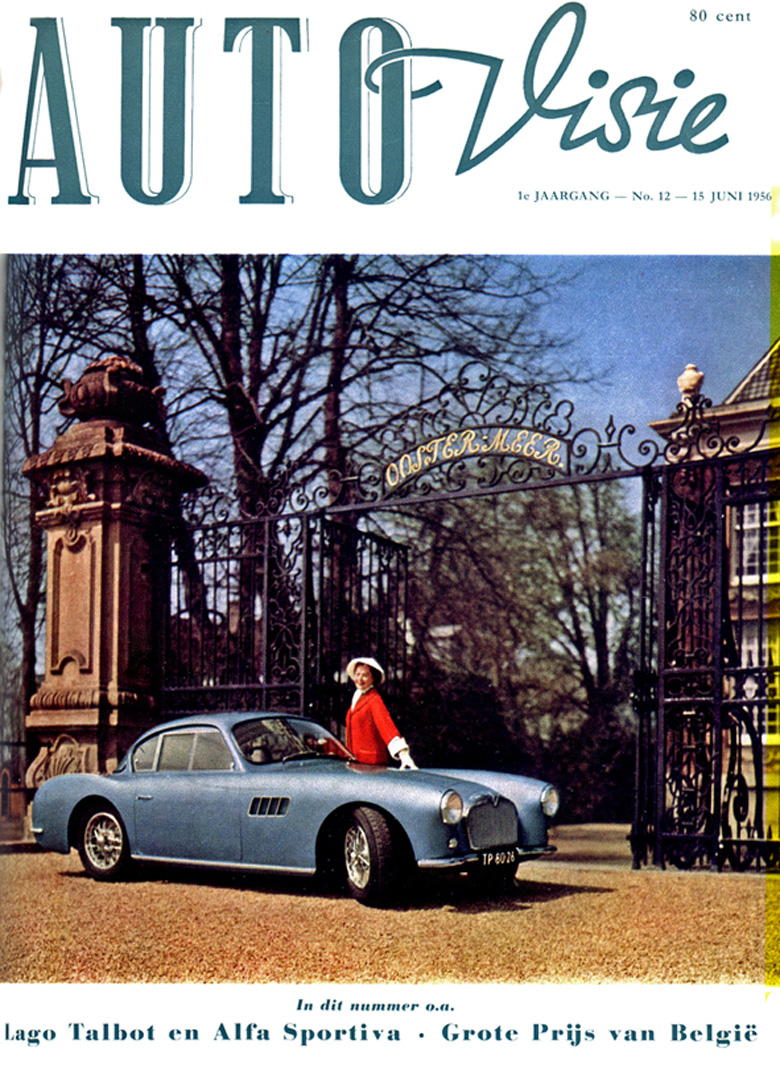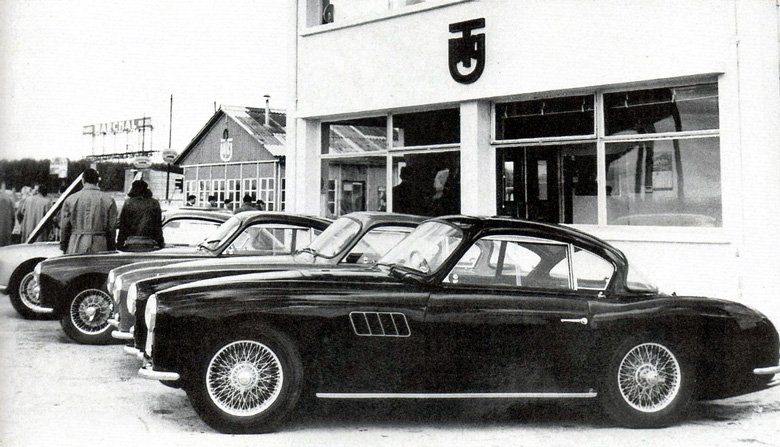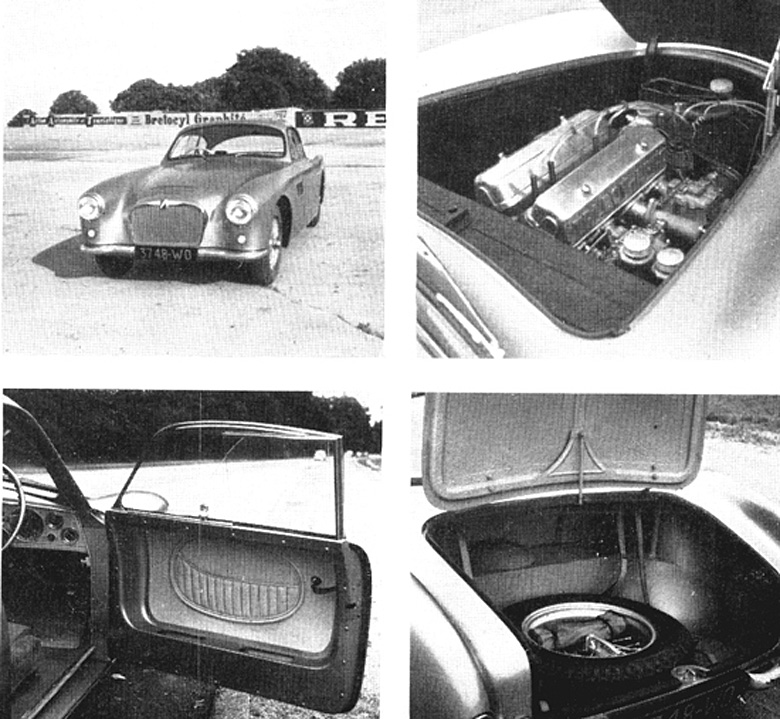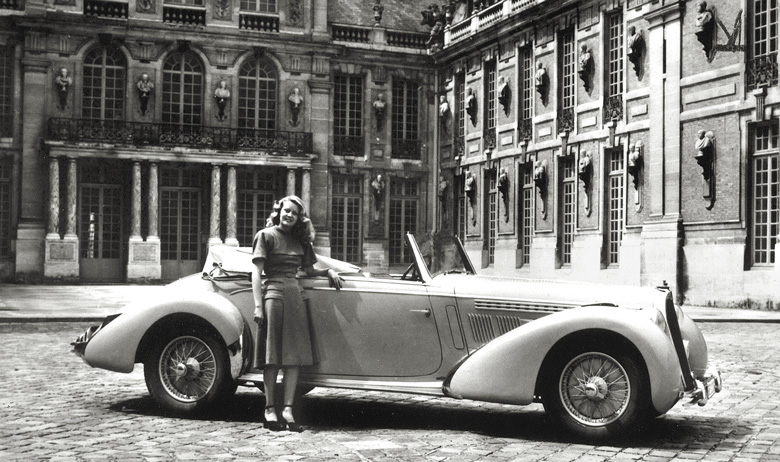To accompany our stories about the Grand Sport, we asked Gijsbert-Paul Berk if he had a favorite Talbot-Lago. Reaching into his huge bank of automotive experiences, he told us about driving the ultra-rare 2.5 liter 1955-56 Gran Turismo coupe on the banking at Montlhéry. Above, the author’s test car, a Talbot 2.5 liter GT coupé on the cover of the June 1956 issue of the Dutch magazine “Autovisie”. The photo was taken in front of the gate of the stately house called Oostermeer on the bank of the river Amstel near Amsterdam.
I have never owned a Talbot-Lago and they were never on my shortlist. The main reason for this is that when they were new, they were far beyond my financial scope. When they were affordable, as second hand cars, the factory no longer existed, so service and spare parts were a problem. So, it is not that I dislike Anthony Lago’s Talbots; I have driven 4.5 liter sedans, owned by friends. In 1956 I even drove a 2.5 liter GT coupé on the Montlhéry circuit in France. But it was not in a race.
In those days the French car manufacturers organized a test day for journalists during the Paris Motor Show, just as the British SMMT did at Goodwood. The Montlhéry race track consisted of the famous banked oval used for record runs, and a winding road circuit with a lot of slower curves. Journalists could drive the bread and butter cars themselves. This was not the case with the blue 2.5 liter Talbot-Lago GT coupé. However, it was possible to have a factory driver show you the possibilities of this fast and exclusive machine on the banked track. A favorite demonstration of these drivers was to take the car up to 160 km/h (100 mph), go to a certain level on the banking and take their hands from the steering wheel. The car would stay on course. In fact everybody could do it, but as the road surface on the banking was bad and bumpy it was not a trick for amateurs. Fortunately the Talbot importer from Amsterdam was also present. He had it arranged so that I could drive a few laps in the Talbot myself, albeit accompanied by the factory driver. He also promised that when we returned to the Netherlands, he would lend us his own demonstrator so I could drive the car in normal conditions. I could then write a short ‘road impression’ of this car in the Dutch magazine Autovisie. But he warned me that his car had only done 8000 km and according to him was not fully run in, so would I please not take it to its limits.
I liked the body style of this small Talbot-Lago coupé. It was in fact a downsized clone of the 4.5 liter coupé designed by Carlo Delaisse. The chassis was constructed from large diameter tubes, it had independent front suspension and a conventional rear axle with leaf springs. Contrary to the larger Talbot-Lagos, the 2.5 liter was not equipped with a Wilson preselector gearbox; the customer could choose between a manual four-speed box made by Pont-à-Mouson, or one manufactured by ZF. Upon opening the bonnet, the engine looked as if it had twin overhead camshafts, but although its aluminum cylinder-head had hemispherical combustion chambers, the valves were operated by a camshaft down in the block. A technical solution Talbot-Lago also used in his prewar models and his designer Walther Becchia – since the early 1940s working for Citroën – incorporated this system in his air-cooled two-cylinder boxer of the 2 Cheveaux. Thanks to its five bearing crankshaft the engine seemed quite robust and could withstand 5500 rpm. Peak power was 120 bhp at 5000 rpm.
Summarizing what I wrote in 1956: Good all round vision, comfortable bucket seats, reassuring road holding, with a slight tendency to oversteer on wet roads. Fortunately it featured a direct and relatively light steering to correct rear-end break-away, and really excellent brakes. But the 2.5 liter four cylinder was rather rough and the interior quite spartan. To keep the weight of the car down (1000 kg) and create optimal elbow room, the doors were hollow and fitted with horizontal ‘sliding’ windows, just like in the old Renault Quatre I once owned. These sliding windows provided good draft-free ventilation, but when closed also caused a whistling wind-noise at higher speeds. For a competition car the noise level was acceptable, but in a GT machine is was somewhat irritating.
But basically the Talbot-Lago 2.5 liter GT was pleasant to live with. The few details that needed further refinement were in due course improved. From the end of 1956 the cars had conventional roll up side windows and in 1967 the 2.5 liter four-cylinder engine was replaced by a slightly downsized from 2.580 liter to 2.476 liter V8 of BMW 502 origin. I found this transformation – the model was then called the Talbot Lago America – very attractive. What unfortunately remained was its high price: some 40% more than a Jaguar XK 140. (In 1957 I was able to buy a splendid XK 120 Drophead Coupé for the price of a new Volkswagen, from an American pilot who returned to the US from the Soesterberg airbase. When our daughter grew too big to fit between her mother and me in the narrow two-seater cockpit, I was had to exchange it for a family car, a move I still regret!)
If I had to choose a postwar Talbot-Lago, it would not be it the 2.5 GT coupé nor the America. My favorite would be the 1951/52 factory-bodied four-seater convertible with the 4.5 liter engine and a Wilson préselector gearbox. This was on the Record chassis, with coil spring independent front suspension. I like it for its style and the possibility of effortless cruising at 110-120 km/h along the long and winding French Routes Nationales. Just the car to take a gorgeous girl with you on a journey from the Place de Saint Germain-des-Prés in Paris to the Promenade des Anglais in Nice.
That was in the fifties and sixties. Today we would take the TGV express train!



